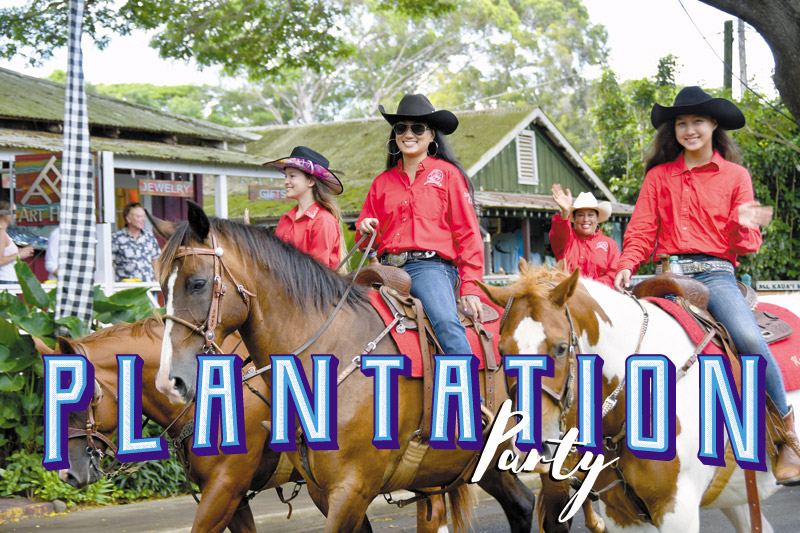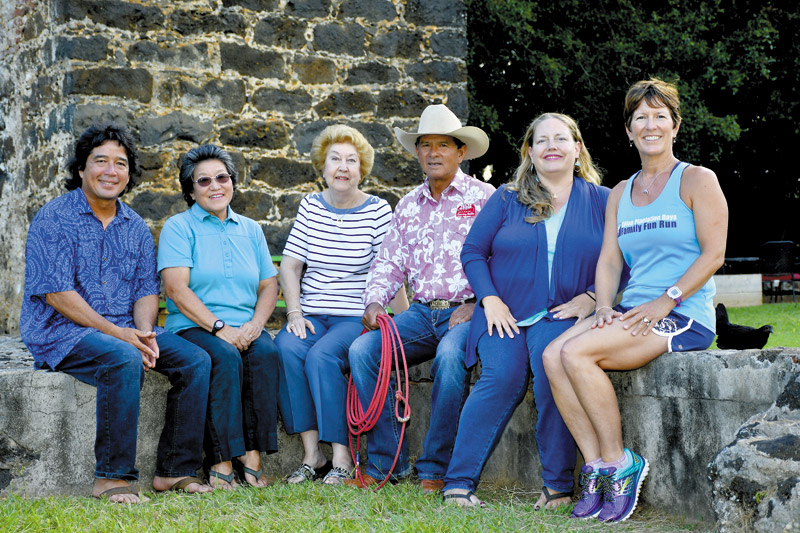Plantation Party

The paniolo lifestyle is a big part of Kaua‘i’s history and is celebrated during Koloa Plantation Days.
Koloa Plantation Days kicks off its 32nd year this weekend, and continues the tradition of recognizing different customs, foods and stories that make up Kaua‘i’s unique culture.
The kau kau tin, a double decker lunchbox that plantation employees used to carry to work, is symbolic of this year’s Kōloa Plantation Days theme, “Many Cultures, One Community.” The bottom portion of the kau kau tin (kau kau is the Hawaiian Pidgin English word for “to eat”) traditionally contained rice. The top was a variation of meat that was individualized and flavored according to different cultural cuisines, including Filipino, Portuguese and Japanese. The story goes that the workers often would share their meats with one another, and, therefore, it was one of the ways they’d harmoniously exchange the diversity of their cultures.
At the 32nd annual Kōloa Plantation Days celebration, which begins Friday (July 21), ethnic groups will gather to reminisce about these days of yesteryear, and revitalize the bonds that continue to make Kaua‘i the culturally rich place that it is.

Ladd and Company’s sugar mill smokestack serves as a reminder of early plantation days in Hawai‘i, a time that (from left) Bertram Almeida, Cheryl Shintani, Phyllis Kunimura, Jimmy Miranda, Melissa McFerrin and Fran McDonald wish to celebrate at Koloa Plantation Days.
“Moving to Kaua‘i was a wonderful awaking,” says Phyllis Kunimura, a retired Kōloa Elementary School teacher and co-founder and president of Kōloa Plantation Days, who moved to the island from upstate New York several decades ago.
She still fully embraces living on the island, where people from all walks of life can work and live together cohesively. That’s one of the reasons she made it a mission to honor the multi-ethnic legacy of the south shore community, made possible after the state’s first large-scale sugar mill in Kōloa began operations in 1835, employing people from around the globe.
“It’s too fragile to just let it go,” says Kunimura, who will serve as the parade’s grand marshal this year. “And if you don’t tell the story to your grandchildren and pass those stories on, how are they going to learn?”
Kunimura has been at the event’s helm since 1985, when the first Kōloa Plantation Days event took place — the quaint neighborhood was selected by the Hawai‘i Sugar Planters’ Association to celebrate 150 years of sugar in the state.
Kunimura fondly remembers the first “huge” celebration where vendors lined up along the main street and a sugar cane cutting competition took place in the adjacent field. At the lu‘au that same day, catered by Sueoka’s, she recalls people discussing how much fun they were having.
With the help of her late husband, Tony, who was Kaua‘i’s mayor at the time, she began her journey to keep the event going without the state’s assistance. Each subsequent year (with the exception of a hiatus in1987), the event continued to grow, not only going from one day to a week-and-a-half, but in the number of activities, as well as participants. And after several years on her own, Kunimura reached out to others for help. Now, she calls the community the “nucleus” of the event and says none of it would be possible without the volunteers.
One of those volunteers, Cheryl Shintani, parade coordinator for Kōloa Plantation Days, also a former Kōloa Elementary School teacher, helps arrange the 60-70 units that comprise the Annual Historic Kōloa Plantation Days Parade that takes place this year on July 29 at 10 a.m. She began assisting many years ago when the late “Aunty” Stella Burgess, who helped coordinate the event at the time, asked her to assist.
“And I would do anything for her,” says Shintani.
Bertram Almeida, on the other hand, was asked by Kunimura, who was one of his elementary school teachers, to help.
“I was honored when they asked me,” says Almeida, who grew up in Kōloa.
Volunteers like Melissa McFerrin, who is serving her 10th year as event coordinator, keep coming back to help because she appreciates working together with people from many different backgrounds and hearing stories along the way, such as the history of the kau kau tin.
“I just love it because the people are so passionate about it,” she says. “I meet such incredible people.”
And that’s what keeps thousands of people coming back year after year to attend, including visitors who schedule their trips around the event.
The plethora of activities that take place also are a major draw. Between Friday and July 30, activities will abound like traditional Hawaiian games, the Historic Hapa Trail Walk and Plantation Days Putting Contest.
There’s even a family fun run July 30 at Po‘ipū Beach Park starting at 6:30 a.m. for people of all ages and athletic abilities.
“Anybody can grab a pair of shoes and walk or run,” says Fran McDonald, who serves on the Kōloa Plantation Days committee and is president of Kukui‘ula Outrigger Canoe Club, which hosts the activity.
And then, of course, there’s this weekend’s rodeo, which sets everything into motion beginning Friday at 9 a.m. at CJM Country Stables.
“It’s a bigger and better rodeo,” says Jimmy Miranda of CJM Country Stables on what sets the annual affair apart from others, including cowboys attempting to ride feisty bulls. “You cannot have a good rodeo without bucking bulls.”
Besides giving visitors a chance to experience the paniolo lifestyle, people like Miranda, who also serves on the Kōloa Plantation Days committee, are there to share their own experiences of the south shore’s plantation era. In fact, he vividly remembers the day the Kōloa sugar mill closed, right down to the time — Sept. 16, 1996, at 4 p.m.
He knew many of the workers who, he says, “threw their hard hats in at the end to grind ‘em up” because they no longer had use for them.
“It was so sad,” he says. “And it was a worrisome time because at that point, people really didn’t know what to do,” Kunimura adds.
But the Kōloa Plantation Days celebration never ceased to exist, allowing stories like this to continue to spread. It’s a chance for people to log off from their electronics and make “real connections with people,” says McFerrin. “To take a break and meet your neighbors.”
Koloa Plantation Days, slated for July 21-30, celebrates the rich cultural heritage of the island.
Visit koloaplantationdays.com for a list of scheduled events.





